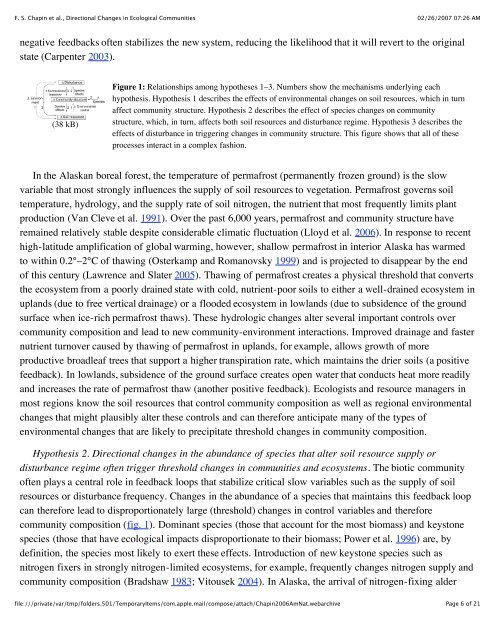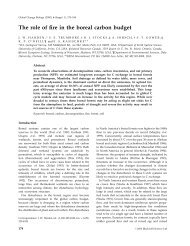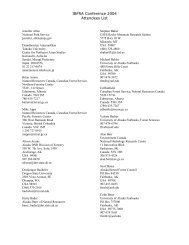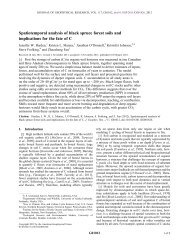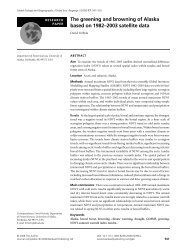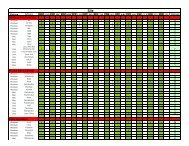Chapin, F.S., III, M.D. Robards, H.P. Huntington, J.F. Johnstone, S.F. ...
Chapin, F.S., III, M.D. Robards, H.P. Huntington, J.F. Johnstone, S.F. ...
Chapin, F.S., III, M.D. Robards, H.P. Huntington, J.F. Johnstone, S.F. ...
You also want an ePaper? Increase the reach of your titles
YUMPU automatically turns print PDFs into web optimized ePapers that Google loves.
F. S. <strong>Chapin</strong> et al., Directional Changes in Ecological Communities<br />
02/26/2007 07:26 AM<br />
negative feedbacks often stabilizes the new system, reducing the likelihood that it will revert to the original<br />
state (Carpenter 2003).<br />
(38 kB)<br />
Figure 1: Relationships among hypotheses 1–3. Numbers show the mechanisms underlying each<br />
hypothesis. Hypothesis 1 describes the effects of environmental changes on soil resources, which in turn<br />
affect community structure. Hypothesis 2 describes the effect of species changes on community<br />
structure, which, in turn, affects both soil resources and disturbance regime. Hypothesis 3 describes the<br />
effects of disturbance in triggering changes in community structure. This figure shows that all of these<br />
processes interact in a complex fashion.<br />
In the Alaskan boreal forest, the temperature of permafrost (permanently frozen ground) is the slow<br />
variable that most strongly influences the supply of soil resources to vegetation. Permafrost governs soil<br />
temperature, hydrology, and the supply rate of soil nitrogen, the nutrient that most frequently limits plant<br />
production (Van Cleve et al. 1991). Over the past 6,000 years, permafrost and community structure have<br />
remained relatively stable despite considerable climatic fluctuation (Lloyd et al. 2006). In response to recent<br />
high-latitude amplification of global warming, however, shallow permafrost in interior Alaska has warmed<br />
to within 0.2°–2°C of thawing (Osterkamp and Romanovsky 1999) and is projected to disappear by the end<br />
of this century (Lawrence and Slater 2005). Thawing of permafrost creates a physical threshold that converts<br />
the ecosystem from a poorly drained state with cold, nutrient-poor soils to either a well-drained ecosystem in<br />
uplands (due to free vertical drainage) or a flooded ecosystem in lowlands (due to subsidence of the ground<br />
surface when ice-rich permafrost thaws). These hydrologic changes alter several important controls over<br />
community composition and lead to new community-environment interactions. Improved drainage and faster<br />
nutrient turnover caused by thawing of permafrost in uplands, for example, allows growth of more<br />
productive broadleaf trees that support a higher transpiration rate, which maintains the drier soils (a positive<br />
feedback). In lowlands, subsidence of the ground surface creates open water that conducts heat more readily<br />
and increases the rate of permafrost thaw (another positive feedback). Ecologists and resource managers in<br />
most regions know the soil resources that control community composition as well as regional environmental<br />
changes that might plausibly alter these controls and can therefore anticipate many of the types of<br />
environmental changes that are likely to precipitate threshold changes in community composition.<br />
Hypothesis 2. Directional changes in the abundance of species that alter soil resource supply or<br />
disturbance regime often trigger threshold changes in communities and ecosystems. The biotic community<br />
often plays a central role in feedback loops that stabilize critical slow variables such as the supply of soil<br />
resources or disturbance frequency. Changes in the abundance of a species that maintains this feedback loop<br />
can therefore lead to disproportionately large (threshold) changes in control variables and therefore<br />
community composition (fig. 1). Dominant species (those that account for the most biomass) and keystone<br />
species (those that have ecological impacts disproportionate to their biomass; Power et al. 1996) are, by<br />
definition, the species most likely to exert these effects. Introduction of new keystone species such as<br />
nitrogen fixers in strongly nitrogen-limited ecosystems, for example, frequently changes nitrogen supply and<br />
community composition (Bradshaw 1983; Vitousek 2004). In Alaska, the arrival of nitrogen-fixing alder<br />
file:///private/var/tmp/folders.501/TemporaryItems/com.apple.mail/compose/attach/<strong>Chapin</strong>2006AmNat.webarchive<br />
Page 6 of 21


